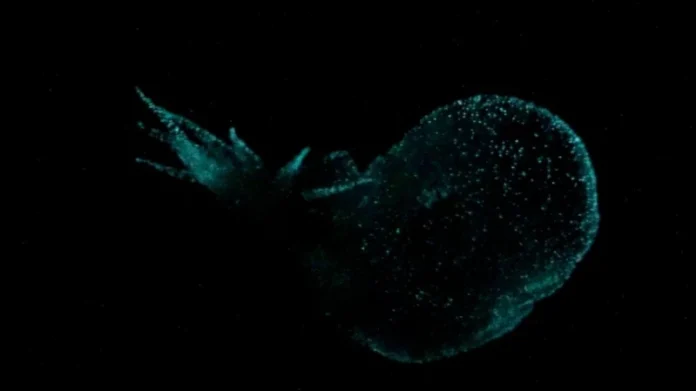Researchers Discover New Species of Bioluminescent Sea Slug in the Ocean’s Midnight Zone
Marine scientists have made a groundbreaking discovery in the midnight zone, a vast, mysterious part of the ocean that lies between 3,300 and 13,100 feet (1,000 to 4,000 meters) below the surface. This habitat, known for its perpetual darkness and extreme pressure, has revealed a new resident: a glowing, paddle-tailed sea slug named Bathydevius caudactylus.
This remarkable species, first observed by researchers from the Monterey Bay Aquarium Research Institute (MBARI), challenges preconceived notions about sea slug behavior and habitat. Unlike its coastal and shallow-water relatives, Bathydevius caudactylus thrives in the open waters of the deep ocean, far from the familiar seafloor environments where sea slugs are usually found.
Sea slugs, scientifically classified as nudibranchs, are soft-bodied marine gastropod mollusks. While most nudibranchs are known for their vibrant colors and intricate forms, Bathydevius caudactylus the sea slug distinguishes itself with its unique adaptations designed to survive the harsh conditions of the midnight zone.
One of the most striking features of this new species is its bioluminescence. Bathydevius caudactylus glows in the dark, a characteristic that may serve multiple purposes, from attracting prey to deterring predators. Its body is equipped with a large, gelatinous hood and a paddle-like tail, which allow it to swim efficiently through the deep waters. This combination of physical traits is unprecedented among nudibranchs, marking a significant deviation from the typical crawling behavior seen in coastal species.
The midnight zone is the largest habitat on Earth, encompassing around 70% of the planet’s seawater. This deep-ocean environment is characterized by its complete absence of sunlight, frigid temperatures, and immense pressure. For most organisms, these conditions are inhospitable. However, Bathydevius caudactylus sea slug has evolved specific adaptations that allow it to thrive in this extreme environment.
Unlike its shallow-water counterparts that often cling to rocks or coral reefs, this sea slug is a free swimmer, navigating the vast, open waters of the deep sea. Such mobility is rare among nudibranchs, making this discovery even more extraordinary.
The discovery of Bathydevius caudactylus has been a long journey. MBARI senior scientists Bruce Robison and Steven Haddock first encountered this enigmatic sea slug in February 2000 during a deep-sea expedition off the coast of Monterey Bay. Using the remotely operated vehicle (ROV) Tiburon, the researchers captured their first glimpse of what they would later call the “mystery mollusk.”
Since that initial sighting, MBARI scientists have recorded over 150 encounters with Bathydevius caudactylus. These repeated sightings have allowed researchers to study its behavior, morphology, and habitat in greater detail.
The discovery of Bathydevius caudactylus provides valuable insights into the ecology of the midnight zone. As the largest habitat on Earth, the midnight zone remains one of the least understood ecosystems. Its vast expanse harbors a myriad of species, many of which have yet to be discovered.

The identification of a new sea slug species highlights the rich biodiversity of the deep ocean. It underscores the importance of continued exploration and study of these remote environments. By understanding the unique adaptations of organisms like Bathydevius caudactylus, scientists can gain a better understanding of how life persists in one of the most extreme habitats on the planet.
Robison, co-lead author of the study published in the journal Deep Sea Research Part I, emphasized the significance of this discovery. “We’ve invested more than 20 years in understanding the natural history of this fascinating species of nudibranch,” he stated. “Our discovery is a new piece of the puzzle that can help better understand the largest habitat on Earth.”
The study of Bathydevius caudactylus not only enriches our knowledge of nudibranchs but also contributes to a broader understanding of deep-sea ecosystems. These findings can inform conservation efforts, particularly as human activities such as deep-sea mining and climate change threaten these fragile environments.
Exploring the midnight zone poses significant challenges due to its depth and inaccessibility. Traditional methods of marine research, such as diving and surface-based observations, are ineffective at these depths. Instead, scientists rely on advanced technology like ROVs and autonomous underwater vehicles (AUVs) to navigate and study the deep sea.
The ROV Tiburon, used by MBARI, is a prime example of how technology has revolutionized deep-sea exploration. Equipped with high-definition cameras and sophisticated sampling tools, Tiburon has enabled researchers to observe and collect data on species like Bathydevius caudactylus in their natural habitats.
The discovery of Bathydevius caudactylus opens new avenues for research. Scientists are particularly interested in understanding the evolutionary pathways that led to the development of its unique adaptations. Comparing the genetic makeup of this deep-sea nudibranch with its shallow-water relatives could provide insights into how species evolve to survive in extreme environments.
Additionally, further study of its bioluminescent properties could have practical applications. Bioluminescence has already found uses in medical and technological fields, and understanding how deep-sea organisms produce and utilize light could lead to new innovations.
Sea slugs, including nudibranchs like Bathydevius caudactylus, play vital roles in marine ecosystems. They often serve as both predators and prey, contributing to the balance of the food web. In shallow waters, nudibranchs are known to feed on sponges, corals, and even other nudibranchs. However, the diet of Bathydevius caudactylus remains a subject of ongoing research, as scientists work to uncover more about its ecological role in the midnight zone.
As the deep sea becomes increasingly accessible due to technological advancements, it faces growing threats from human activities. Deep-sea mining, in particular, poses a significant risk to the fragile ecosystems of the midnight zone. The discovery of unique species like Bathydevius caudactylus underscores the importance of preserving these habitats.
Conservation efforts must prioritize the protection of deep-sea environments to ensure the survival of their diverse and often fragile inhabitants. By raising awareness of the unique life forms that call the midnight zone home, scientists and conservationists hope to garner support for sustainable practices and protective measures.
The discovery of Bathydevius caudactylus represents a significant milestone in marine science, shedding light on the hidden wonders of the midnight zone. This bioluminescent sea slug, with its unique adaptations and behaviors, offers a glimpse into a world that remains largely unexplored.
As researchers continue to study this fascinating species, they will undoubtedly uncover more secrets of the deep sea. Each discovery brings us closer to understanding the complexities of life in the ocean’s most mysterious realm, highlighting the importance of exploration, conservation, and scientific inquiry in the pursuit of knowledge.
At first glance, the newly discovered sea slug Bathydevius caudactylus resembles a peculiar combination of shapes. Co-lead study author Steven Haddock describes it as looking “more like a megaphone with a feathered tail” than a traditional sea slug. Its unusual physical characteristics and the extreme depths at which it lives make it one of the most fascinating marine animals ever recorded.
This enigmatic sea slug, found thriving in the ocean’s midnight zone, sports a massive, bowl-shaped hood at one end of its body, while its tail, flat and fringed with fingerlike projections, gives it a distinctive appearance. Between these two ends, its colorful internal organs are visible through its translucent body. The creature also has a snail-like foot, which initially puzzled researchers and made them question what type of mollusk it truly was.
The deep ocean waters off the Pacific Coast of North America, stretching from Oregon to Southern California, have been the primary regions where the underwater research robot Tiburon has encountered Bathydevius caudactylus. However, additional sightings by researchers from the National Oceanic and Atmospheric Administration (NOAA) in the Mariana Trench, located in the Western Pacific, suggest that this sea slug has a much broader habitat range than previously believed.
To better understand this strange sea slug, the research team collected a specimen for closer examination in the lab. A detailed study of its anatomy and genetics revealed that the creature belongs to the nudibranch family. However, Bathydevius caudactylus is unlike any other nudibranch known to science, having adapted to thrive in the cold, dark waters of the midnight zone.
Bruce Robison, a senior scientist and co-author of the study, expressed amazement at this discovery. “The deep water column is maybe the last place you’d expect to find a nudibranch,” he said. “It’s sort of like finding hummingbirds near the peak of Mt. Everest.” Despite the forbidding nature of the midnight zone, with its frigid temperatures and perpetual darkness, it teems with life. What makes Bathydevius caudactylus unique is how every aspect of its biology—anatomy, physiology, reproduction, feeding, and behavior—reflects adaptations specifically designed for this harsh environment.

The researchers named the species Bathydevius caudactylus for a reason. The name “Bathydevius” hints at its devious nature, as it initially confounded scientists about its classification. Meanwhile, “caudactylus” refers to the fingerlike projections, or dactyls, found on its tail.
Unlike typical sea slugs, which use a raspy tongue to scrape or capture prey from the seafloor, Bathydevius caudactylus employs a far more specialized hunting technique. It uses its large, hood-like structure to trap fast-moving prey such as mysid shrimp. This method allows it to thrive in the open waters of the midnight zone, where such prey is abundant.
When animals transition from life on the seafloor to a drifting existence in the water column, they often evolve to become larger, more transparent, and more fragile. Haddock explains that many deep-sea animals, such as jellyfish, rely on stinging cells to subdue their prey. However, Bathydevius caudactylus takes a different approach.
“For this nudibranch and some other deep-sea animals, they engulf their prey,” Haddock explained. “Instead of being stronger than their dinner, their flexibility absorbs the struggling movements and smothers them as if with a wet blanket.”
Survival in the midnight zone requires a range of clever tactics, and Bathydevius caudactylus is a master of adaptation. Its movement is fascinating; it propels itself up and down the water column either by flexing its body or by drifting along with the ocean currents.
When it’s time to reproduce, the sea slug descends to the seafloor and temporarily uses its foot to anchor itself. Like many other nudibranchs, Bathydevius caudactylus is a hermaphrodite, meaning it possesses both male and female reproductive organs. This adaptation increases its chances of successful reproduction in an environment where encounters with other members of its species may be rare.
In terms of defense, the sea slug relies on its transparent body as a form of camouflage, effectively hiding it from predators. If danger arises, it can rapidly close its large hood to propel itself backward, enabling a swift escape. Additionally, its ability to emit bioluminescent light serves as a defensive mechanism, distracting potential threats.
Bioluminescence is one of the most fascinating characteristics of Bathydevius caudactylus. The sea slug’s tissues contain luminous granules that create a starry appearance across its back. This glow not only helps the animal evade predators but also adds to its unique allure as one of the deep ocean’s most intriguing inhabitants.
The midnight zone, a vast and largely unexplored region of the ocean, poses extreme challenges for survival. The absence of sunlight, combined with freezing temperatures and crushing pressures, makes it one of the most inhospitable environments on Earth. However, it is also the planet’s largest habitat, home to an astonishing variety of life forms.
The discovery of Bathydevius caudactylus in this environment highlights the remarkable diversity of life in the deep sea and raises questions about how many other unique species remain undiscovered. The adaptations of this sea slug are a testament to the incredible resilience and versatility of marine life.
The discovery of Bathydevius caudactylus underscores the critical role of deep-sea exploration in advancing our understanding of marine biodiversity. For decades, researchers have relied on advanced technology such as remotely operated vehicles (ROVs) to explore these inaccessible regions. The ROV Tiburon, equipped with high-definition cameras and specialized sampling tools, has been instrumental in documenting encounters with this elusive sea slug.
As Haddock and Robison’s work demonstrates, there is still much to learn about the creatures that inhabit the midnight zone. Each discovery not only enriches our understanding of marine ecosystems but also sheds light on the broader processes that drive life on Earth.
The study of Bathydevius caudactylus is far from over. Future research will likely focus on understanding its genetic makeup and evolutionary history, which could provide insights into how life adapts to extreme environments. Moreover, its unique method of prey capture and bioluminescence could have practical applications in fields such as biotechnology and medicine.
Conservation efforts are also crucial. As human activities such as deep-sea mining and climate change pose increasing threats to marine habitats, protecting the midnight zone and its inhabitants has never been more important. By raising awareness of the unique species that call this region home, scientists hope to inspire more sustainable practices and policies.
Bathydevius caudactylus is more than just a new species of sea slug; it’s a symbol of the wonders that await discovery in the deep sea. With its glowing body, ingenious hunting tactics, and remarkable adaptations, this creature offers a glimpse into a world that remains largely hidden from view.
As exploration of the midnight zone continues, it’s clear that the ocean holds many more secrets. Each discovery not only broadens our scientific knowledge but also deepens our appreciation for the extraordinary diversity of life on our planet.

Bioluminescence, while widespread in the deep ocean, is an uncommon trait among sea slugs. According to Haddock, approximately three-quarters of marine animals living in the water column possess this ability, but it has only been observed in a few nudibranch species.
“This discovery marks only the third instance of bioluminescence evolving independently in a nudibranch,” Haddock explained. “It raises fundamental questions about its origins. We still don’t know what chemicals enable this sea slug to emit light, which genes are responsible, or how this extraordinary trait appeared seemingly out of nowhere.” What makes this even more intriguing is that Bathydevius caudactylus lacks close relatives among other mollusks, making its evolution of bioluminescence a unique event in the tree of life.
Despite its evolutionary ingenuity, Bathydevius caudactylus and its deep-sea habitat face significant threats, particularly from human activities like deep-sea mining. This process involves extracting valuable materials from the seafloor and creates vast plumes of sediment that rise into the water column. After minerals are separated, the sediment is pumped back into the ocean, potentially disrupting the delicate balance of deep-sea ecosystems.
Bruce Robison, senior scientist and co-author of the study, warned of the potential risks: “The ability of Bathydevius caudactylus to spawn on the seafloor and live, hunt, and feed in the water column makes it especially vulnerable to sediment clouds and habitat disturbances caused by mining operations.”
The discovery of unique species like Bathydevius caudactylus highlights the importance of preserving deep-sea environments. Beyond their scientific significance, these creatures capture the public’s imagination and emphasize the interconnectedness of life on Earth.
“Deep-sea animals like this sea slug remind us that we share our planet with extraordinary neighbors,” Robison noted. “Each new discovery offers a chance to inspire public interest and bolster efforts to protect the incredible biodiversity found in the ocean’s depths.”
As researchers continue to explore the mysterious midnight zone, their findings not only expand our understanding of life in extreme environments but also underscore the need for sustainable ocean practices. Preserving this fragile ecosystem ensures that species like Bathydevius caudactylus can continue to thrive and provide invaluable insights into the evolutionary wonders of our planet.




